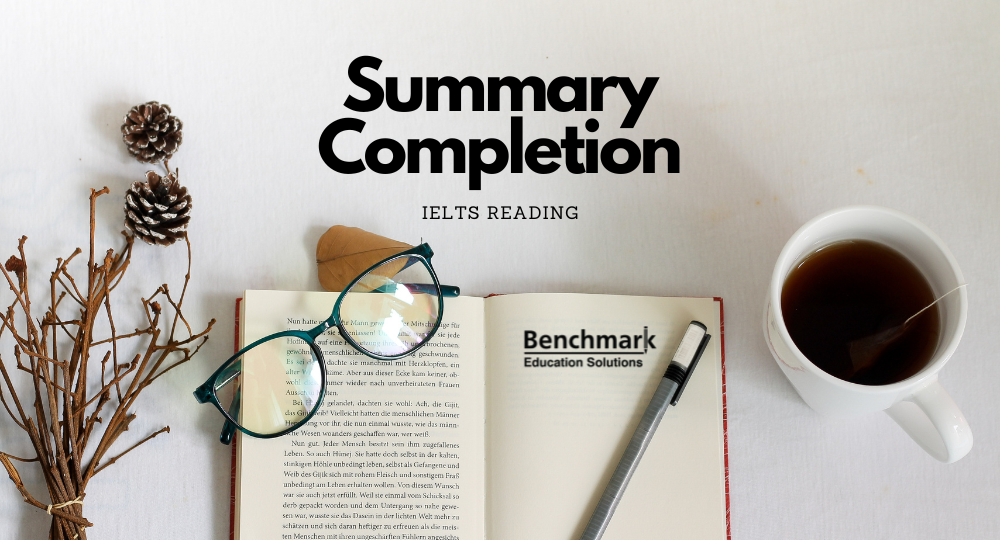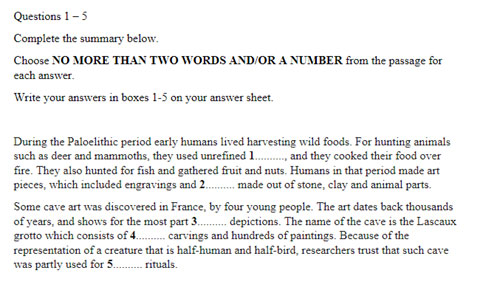

Table of Contents
1. What Is Summary Completion?
A summary provides a short and clear description of content mentioned in a text or a speech. In IELTS Reading, there will be a summary that will re-tell the main ideas of a text. That summary will have gaps that must be filled using words from the passage or from a list of options.
Understanding the general meaning of the passage is a challenge to some candidates, and strong skimming and scanning skills are necessary for the completion of such task.
2. How Will the Question Appear in the Real IELTS Reading Exam?


3. Top 5 General Tips for All IELTS Reading Question Types:
- Always ensure that you read and understand the instructions
- Skim the text – quickly read it to get the general meaning
- Scan the text – quickly read it to identify detailed information
- There are no negative marks in IELLTS so do not leave any answer blank – always give it your best shot.
- Be mindful of time – spend 20 minutes at the most on each passage. You have a total of 60 minutes to study 3 texts, answer question and transfer them to your answers sheet.
4. Tips for This Summary Completion Question Type:
4.1 Ensure that you read and understand the instructions. If the instructions say you must choose an answer from a list of options, you must use that list. The answers will be preceded by letters, for example A-G, and you may only use those letters as your answers. If you write the word instead of the letter, your answer will be marked as incorrect, and you will not gain a point even if your answer is correct.
If the instructions state that you must use words from the passage, they will inform you of how many words you are allowed to use, such as: ‘you may use no more than 2 words from the passage’. In this case, you will therefore only be allowed to use 1 or 2 words from the text as your answer for each gap. If you use more than the number indicated in the instructions, your answer will be counted as incorrect, even if it contains the correct answer. To better understand such instructions, click here.
4.2 If the instructions tell you to use words from the passage, make sure you only use words taken directly from the passage. You may not paraphrase or use your own words to fill in the gaps, or those will be considered incorrect, even if the meaning is correct.
4.3 Because this question requires you to understand general meaning, make sure that you pay attention to all the information provided, including the title, which should give you an idea of what the text is going to be about.
4.4 Skim the summary first. Read them quickly to get a basic understanding of their content. Then, read them again in more detail to understand the kind of information and language you need to identify in the passage.
4.5 Paraphrasing is key. To complete this task effectively and efficiently, identify the key language in the title and in the summary, and paraphrase that key language (say what it means in other words). The summary will not always contain the same words as in the text, as it will be re-explaining what the text says. Therefore, paraphrasing key words and phrases in the question and title may provide you with words that are actually located in the text. Use your scanning skills to search for those paraphrases in the text, and once you have identified them, read around them to locate the language you need to use as your answer.
Some key information you will be able to paraphrase, such as verbs (e.g.: ‘cry’ could also be ‘weep’ of ‘whine’), but other key information may include names or dates that cannot be paraphrased, although will be easier to identify in the text.
4.6 Pay attention to the grammar around the gaps in the questions. The grammar being used will be a good indicator of the type of language you will need to choose as your answer (verb, noun, adjective, etc). For instance, if the gap is preceded by ‘want to’, it is safe to assume the necessary language to fill in the gap will be a verb. Analyse the grammar to predict the type of missing language. If you need to choose an answer from a list of options, make sure that it makes grammatical sense.
4.7 Answers usually come in order, which will be helpful in locating the information and answers more efficiently.
4.8 Be very mindful of time – spend 1 or 2 minutes skimming the text, and do not try to understand every single word. The goal is to gain a general understating of the text. Detailed reading only comes in when you have scanned and located key information in the text that will help you decide on your answer for the gap. To help with time-management, read the first and last sentences of the text, and the first sentence of each paragraph will normally describe the theme of the paragraphs.
5. Good to Know
5.1 Instructions that contain word limits may seem ambiguous, but here is a detailed explanation for what they mean:
Example: YOU MAY USE NO MORE THAN 2 WORDS AND/OR A NUMBER
Meaning: You may use: 1 word
OR
2 words
OR
1 number
OR
1 word + 1 number
OR
2 words + 1 number
5.2 If a number is expressed in letter form and contains more than one word (e.g: ‘forty-six’), it still counts as one word. In this case: ‘forty-six years old’ has 4 words, but ‘forty-six’ is considered a single word, so ‘forty-six years old’ equals 1 number + 2 words.
5.3 Words that us hyphens (-) such ‘cold-blooded’ or ‘fun-loving’ count as one word.
5.4 If you find key words in the questions that are easily identifiable in the text or which you have previously found through skimming the text, answer those questions first, but ensure that you study those parts of the text carefully before deciding on an answer.
5.5 Do not rush your answers. If you need to choose answers from a list, several options may seem grammatically correct and/or content-appropriate for one gap. It is crucial that you focus on the meaning of the sentence surrounding the gap, so that you can choose the most suitable option.
6. Example:
7. Mock Test
Life and Art in the Stone Age
In the Paleolithic period (roughly 2.5 million years ago to 10,000 B.C.), early humans lived in caves or simple huts or tepees and were hunters and gatherers. They used basic stone and bone tools, as well as crude stone axes, for hunting birds and wild animals. They cooked their prey, including woolly mammoths, deer and bison, using controlled fire. They also fished and collected berries, fruit and nuts.
Ancient humans in the Paleolithic period were also the first to leave behind art. They used combinations of minerals, ochres, burnt bone meal and charcoal mixed into water, blood, animal fats and tree saps to etch humans, animals and signs. They also carved small figurines from stones, clay, bones and antlers.
Near Montignac, France, a collection of prehistoric cave paintings are discovered by four teenagers who stumbled upon the ancient artwork after following their dog down a narrow entrance into a cavern. The 15,000- to 17,000-year-old paintings, consisting mostly of animal representations, are among the finest examples of art from the Upper Paleolithic period.
First studied by the French archaeologist Henri-Édouard-Prosper Breuil, the Lascaux grotto consists of a main cavern 66 feet wide and 16 feet high. The walls of the cavern are decorated with some 600 painted and drawn animals and symbols and nearly 1,500 engravings. The pictures depict in excellent detail numerous types of animals, including horses, red deer, stags, bovines, felines, and what appear to be mythical creatures. There is only one human figure depicted in the cave: a bird-headed man with an erect phallus. Archaeologists believe that the cave was used over a long period of time as a center for hunting and religious rites.
Questions 1 – 5
Complete the summary below.
Choose NO MORE THAN TWO WORDS AND/OR A NUMBER from the passage for each answer.
Write your answers in boxes 1-5 on your answer sheet.








